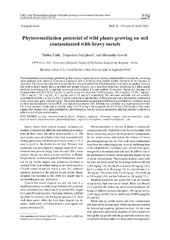Приказ основних података о документу
Phytoremediation potential of wild plants growing on soil contaminated with heavy metals
| dc.creator | Cudić, Vladica | |
| dc.creator | Stojiljković, Dragoslava | |
| dc.creator | Jovović, Aleksandar | |
| dc.date.accessioned | 2022-09-19T18:05:11Z | |
| dc.date.available | 2022-09-19T18:05:11Z | |
| dc.date.issued | 2016 | |
| dc.identifier.issn | 0004-1254 | |
| dc.identifier.uri | https://machinery.mas.bg.ac.rs/handle/123456789/2493 | |
| dc.description.abstract | Phytoremediation is an emerging technology that employs higher plants to cleanup contaminated environments, including metal-polluted soils. Because it produces a biomass rich in extracted toxic metals, further treatment of this biomass is necessary. The aim of our study was to assess the five-year potential of the following native wild plants to produce biomass and remove heavy metals from a polluted site: poplar (Populus ssp.), ailanthus (Ailanthus glandulosa L.), false acacia (Robinia pseudoacacia L.), ragweed (Artemisia artemisiifolia L.), and mullein (Verbascum thapsus L). Average soil contamination with Pb, Cd, Zn, Cu, Ni, Cr, and As in the root zone was 22,948.6 mg kg(-1), 865.4 mg kg(-1), 85,301.7 mg kg(-1), 3,193.3 mg kg(-1), 50.7 mg kg(-1), 41.7 mg kg(-1), and 617.9 mg kg(-1), respectively. We measured moisture and ash content, concentrations of Pb, Cd, Zn, Cu, Ni, Cr, and As in the above-ground parts of the plants and in ash produced by combustion of the plants, plus gross calorific values. The plants' phytoextraction and phytostabilisation potential was evaluated based on their bioconcentration factor (BCF) and translocation factor (TF). Mullein was identified as a hyperaccumulator for Cd. It also showed a higher gross calorific value (19,735 kJ v) than ragweed (16,469 kJ kg(-1)). The results of this study suggest that mullein has a great potential for phytoextraction and for biomass generation, and that ragweed could be an effective tool of phytostabilisation. | en |
| dc.publisher | Inst Medical Research & Occupational Health, Zagreb | |
| dc.relation | Belgrade Institute of Public Health, Serbia | |
| dc.rights | openAccess | |
| dc.rights.uri | https://creativecommons.org/licenses/by/4.0/ | |
| dc.source | Arhiv Za Higijenu Rada I Toksikologiju-Archives of Industrial Hygiene and Toxicology | |
| dc.subject | zinc | en |
| dc.subject | translocation factor | en |
| dc.subject | rhizosphere | en |
| dc.subject | ragweed | en |
| dc.subject | phytostabilisation | en |
| dc.subject | phytoextraction | en |
| dc.subject | nickel | en |
| dc.subject | mullein | en |
| dc.subject | lead | en |
| dc.subject | hyperaccumulator | en |
| dc.subject | copper | en |
| dc.subject | chromium | en |
| dc.subject | cadmium | en |
| dc.subject | biomass | en |
| dc.subject | bioconcentration factor | en |
| dc.subject | arsenic | en |
| dc.title | Phytoremediation potential of wild plants growing on soil contaminated with heavy metals | en |
| dc.type | article | |
| dc.rights.license | BY | |
| dc.citation.epage | 239 | |
| dc.citation.issue | 3 | |
| dc.citation.other | 67(3): 229-239 | |
| dc.citation.rank | M23 | |
| dc.citation.spage | 229 | |
| dc.citation.volume | 67 | |
| dc.identifier.doi | 10.1515/aiht-2016-67-2829 | |
| dc.identifier.fulltext | http://machinery.mas.bg.ac.rs/bitstream/id/1231/2490.pdf | |
| dc.identifier.pmid | 27749263 | |
| dc.identifier.scopus | 2-s2.0-85009788882 | |
| dc.identifier.wos | 000387052000008 | |
| dc.type.version | publishedVersion |


